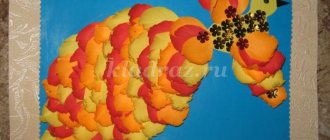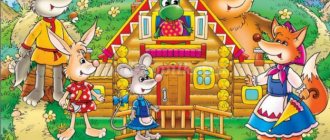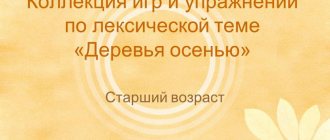MAGAZINE Preschooler.RF
Creative project “Tales of A.S. Pushkin"Municipal state preschool educational institution of the city of Novosibirsk “Kindergarten No. 398 “Swallow” of a combined type”
Teacher of the 1st category: Sysenko T.I.
- Scenario for literary gatherings . ”
- Consultation for parents “Parenting with a fairy tale” .
- Photo vernissage.
PROJECT INFORMATION CARD.
Project type:
— according to the composition of participants: group (children, parents, teacher, colleagues).
- according to the target setting: educational - creative, project participants get acquainted with the literary and fairy-tale heritage of A. S. Pushkin (collect a library, video library, organize an exhibition of children's works, participate in literary gatherings)
Project participants:
- Educators, specialists.
- Children of the senior group in the amount of 20 people.
- Parents.
Venue of preschool educational institution No. 398 “Swallow” , Novosibirsk
Organization of activities of project participants: interaction and cooperation of all project participants
Implementation period: From 12.05.12017 until 06/06/2022 (medium term)
RELEVANCE.
The fairy tale is a lie and there is a hint in it!
A lesson to good fellows.
A. S. Pushkin.
This project was developed for children of the older group, on the eve of the anniversary of the great Russian poet A.S. Pushkin.
Two centuries have passed since Sasha Pushkin heard the old fairy tale about envious sisters and a greedy old woman, but it still captivates the reader with its wonderful fiction and good feelings.
It is easy to imagine the joy of a person who picks up a book of beautiful poetic fairy tales. The impression from such a meeting is unforgettable - so great is the emotional impact of the poetic performance that the great Russian poet A. S. Pushkin unfolds before the reader’s eyes, on the pages of the book. His wonderful gift of telling believably about the most incredible events captivates the reader, forcing him to empathize with the characters, rejoice and grieve with them.
Opening a book, the little reader is as if opening a magical casket with jewels - these poetic lines shining with all colors are so beautiful, so festively elegant. The poet’s fairy-tale world is deeply individual and at the same time in no way diverges from the Russian fairy-tale world. Pushkin drew his multi-colored fairy-tale pattern based on the folk canvas. As in other areas of literature, A.S. Pushkin became the discoverer of new paths in fairy tales. It was he who, by giving classical images of the genre, determined the appearance of the fairy tale, its laws, and showed the measure of the relationship between folk sources and the streams and rivers of written fairy tales that flowed from them. The tales of the great Russian poet are not forgotten throughout his entire life. They are marked by high meaning and poetic skill, making you remember the best moments of the surrounding reality: goodness, beauty, love of life.
PROBLEM:
After reading one of the most beautiful works by A. Pushkin, “The Tale of Tsar Saltan, his son, the glorious and mighty hero Prince Gvidon Saltanovich, and the beautiful Swan Princess,” questions started pouring in from the children: “Who is A. S. Pushkin?” , “Where and when did he live?” , “What other fairy tales does he have?”
The parents also showed interest in the work of the great poet. They asked teachers to help fill the vacuum in the literary reading of A. Pushkin’s works.
PROJECT OBJECTIVES:
- Introducing children to Russian classical literature through acquaintance with the works of A.S. Pushkin
- Development of aesthetic and cognitive aspirations of children of senior preschool age through the best examples of Russian art
— Development of creative abilities in artistic, speech, musical, artistic and productive activities of children and adults.
TASKS:
1. Introduce children to the works of Alexander Sergeevich Pushkin,
his fairy tales for children.
To promote the development of the ability to listen to fairy tales with interest, comprehend what they hear, and memorize excerpts of fairy tales and poems.
2. Develop family reading traditions; to form the interest and desire of children to reflect their impressions in visual and musical activities.
3. Create an atmosphere of emotional comfort, mutual understanding and support; develop communication skills and the ability to communicate with adults and peers in different situations.
EXPECTED RESULTS:
Children have developed an interest in fiction through familiarity with new books - fairy tales by A. S. Pushkin. They listen and watch fairy tales and poems by A.S. Pushkin attentively and with interest. in kindergarten and at home with parents. They read poems and excerpts from fairy tales expressively, with natural intonations. They participate in reading the text and acting out scenes based on familiar fairy tales, using dolls, costume elements, and decorations, and enjoy performing in front of peers, parents, and other guests. Children are familiar with the concept of “folk art” , “folk crafts” .
PROJECT IMPLEMENTATION STAGES:
Stage I - preparatory:
- conversation with parents about the relevance of family reading with children;
- theoretical research on this problem;
- goal setting, development of a project implementation plan; determining how results will be presented.
Stage II - formative (practical)
- replenishment of the development environment (collection of information, material, production of folk costumes and its elements, replenishment of the music and film library);
- acquaintance with various forms of folklore, familiarization with the traditions of folk art;
- mastering the characteristic movements of folk dance;
- learning the Russian folk outdoor game “Golden Gate” ;
- equipping the local history mini-museum “Russian Izba” ;
- organizing and conducting literary gatherings with preschoolers;
- inclusion and interaction with teachers and parents.
Stage III - Final, presentation of the project.
- literary gatherings with preschoolers “There are miracles, there are fairy tales” ;
- exhibition of handicrafts for children and adults;
- exhibition of books based on the works of A.S. Pushkin.
WITH CHILDREN, TEACHERS, PARENTS.
PROJECT RESULTS.
The following people took part in the implementation of the project: children of the senior group and their parents, kindergarten staff.
The following results were obtained: all the fairy tales of the great poet were read with delight. The pupils and their parents got acquainted with the life history and work of the great compatriot. The desire to continue reading other works of A. Pushkin has increased - not only fairy tales, but also poetry. Attributes and costumes for theatrical activities were made. The group has organized a library and video library of cartoons, poems and fairy tales by A. S. Pushkin, which is constantly updated. Children's understanding of folk art, folklore, and music has expanded. The result of all the work on the project can be considered the holding of literary gatherings “There, miracles, there is a fairy tale wandering.
CONCLUSIONS.
The results of our work showed that fairy tales occupy an important place in a child’s life. We managed to interest not only children, but also their parents in the fairy-tale life. The fairy tale returned to the house, to the family, to life. We hope that the educational, ideological, moral, and cultural priorities laid down by fairy tales in preschool childhood will determine the life path of preschoolers and influence the development and state of the entire civilization.
LITERATURE.
- Davydova O.I., Mayer A.A. Bogoslavets L.G. Projects in working with families. M. Sfera, 2012.
- Parfenova E. V. Development of children's speech in theatrical activities. M.: Sfera, 2013.
- Derkunskaya V. A., Oshkina A. A. Game educational activities of preschoolers. M.: Center for Pedagogical Education, 2013.
- Bogatyreva Yu., Bogatyrev A. Preschoolers about Pushkin. Gnome and D, 1999
- Ushakova O. S., Arushanova A. G. Classes on speech development in kindergarten. M., 1998.
- Tales of Pushkin. New format. 2003.
- Fairy tales of Russian writers. Children's book. 1985.
VIDEO LIBRARY.
Soyuzmultfilm 1950 “Collection of cartoons based on fairy tales by A.S. Pushkin"
| Next > |
Project on fairy tales by A.S. Pushkina reading project (2nd grade) on the topic
The tale of the fisherman and the fish tells us about an old man in whose net one day a goldfish was caught. The fish spoke to him in human language and promised to fulfill his wish, which the old woman insisted on. So the old woman got a new trough, but it wasn’t enough for her... She asked for more and more... As a result, the old woman was left with nothing, and the expression “being left with nothing” was firmly established in Russian culture.
The main character, Tsar Saltan, chose a wife from three girls who talked about what they would give to the Tsar. The young wife gave the king a son, Guidon. But it could not have happened without the machinations of Babarikha, who arranged it so that the king ordered the queen and her son to be put in a barrel and thrown into the sea. But the waves threw the mother and child onto a magical island, where they built a city and began to rule it. Guidon grew up and became a handsome, strong, courageous and very fair king. Once he saved a snow-white swan from the evil claws of a bird of prey. She turned into a beauty who helped Guidon see his father. Three times she turned him, first into a mosquito, then into a bumblebee, and Guidon flew to the palace to the king. The Swan Princess also gave Guidon three miracles. Thirty-three heroes who live in the depths of the sea and come ashore to guard the kingdom of Guidon began to serve him. The second gift was a singing squirrel that gnaws emerald nuts. The third miracle was herself. The princess showed her beauty to the young king, who immediately married her. Tsar Saltan nevertheless came to visit Guidon and recognized his wife, obeyed her and his son, and also expelled Baba Babarikha and her henchmen from the city in disgrace.
The tale tells about King Dadon, whose lands were often raided by enemies. The astrologer sage gives him a gift - a golden cockerel, and he will notify the king about the attack of enemies, in return he promises to fulfill any desire. The sage did not make himself known for a long time, and Dadon forgot about his promise. When the king decided to get married, a sage appeared and reminded him of his duty. Then the king, in order not to pay the debt, killed the sage. Retribution comes in the form of a golden cockerel. The main idea of the fairy tale about the golden cockerel is that you must be held accountable for your actions, and as we see, you must always keep your word, even if you don’t want to pay your bills. And of course you must be careful in choosing friends
The fairy tale tells about the enmity between the princess and the queen. As in all fairy tales, here good triumphs over evil. The queen personifies evil, and the princess represents good. The princess is very kind. She tries to please the evil queen in everything and serves her. The princess is modest and quiet because she grew up an orphan and had to work hard. The princess's father chose an evil and greedy woman as his wife.
The princess's stepmother is lazy, she has many servants and does nothing. She is jealous of the princess's youth and beauty and wants to kill her only because the talking mirror considers the princess better than her. The queen tries twice to get rid of the princess. For the second time, the queen’s terrible plan came true and evil triumphed. In reality, everything happened differently. This fairy tale has a happy ending. All the queen's attempts were in vain.
The fairy tale condemns such negative qualities as greed, anger and envy. Because of envy, many suffered: the princess, the prince Elisha, the king, and the queen herself.




